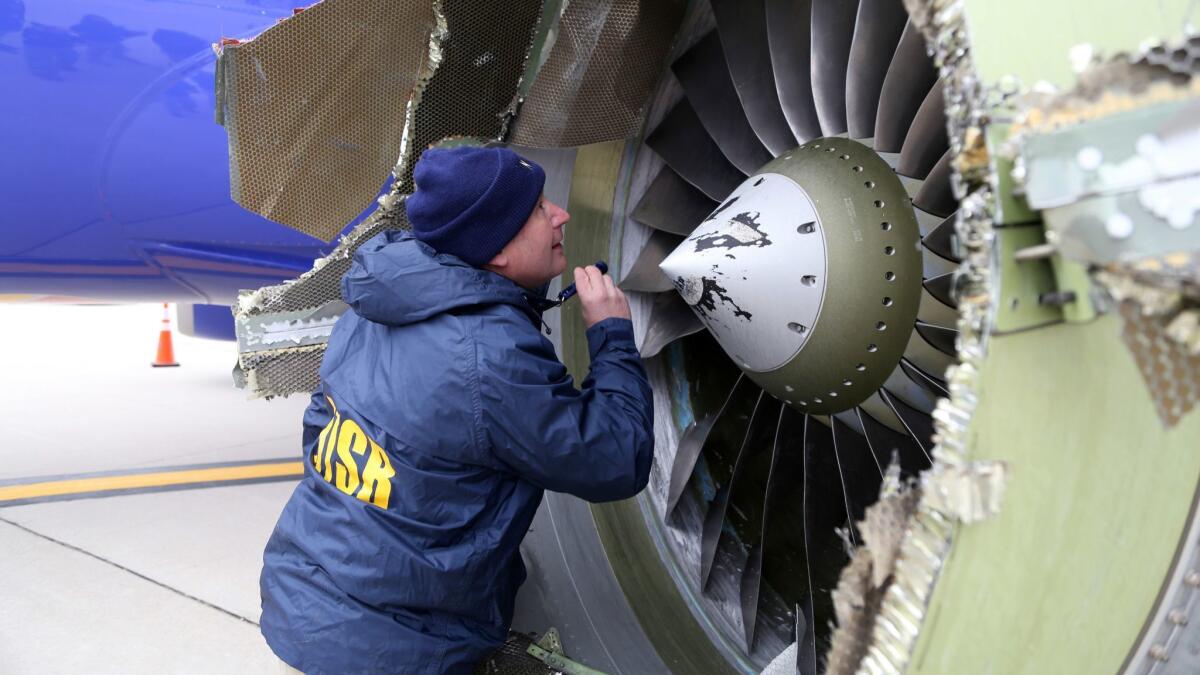FAA orders emergency plane-engine inspections after fatal Southwest accident

U.S. aviation regulators ordered emergency inspections of one of the world’s most popular jet engines after the fatal accident this week on a Southwest Airlines Co. plane.
The Federal Aviation Administration order, issued Friday, covers an estimated 352 CFM International Inc. engines in the United States that have made at least 30,000 flights, the agency said in a statement Friday. The emergency order is effective immediately, and inspections must be completed within 20 days, the FAA said.
The European Aviation Safety Agency is adopting similar requirements, said a person familiar with the matter. There are 681 of the engines worldwide, and regulators in other nations generally follow the FAA’s lead.
The FAA order adds to the scrutiny of the CFM56-7B, the type of engine that blew out Tuesday on Southwest’s Boeing Co. 737. Investigators say a fan blade broke off in flight, triggering a chain of events that shattered one of the plane’s windows.
Passenger Jennifer Riordan, a Wells Fargo & Co. executive and mother of two, died after being partially sucked out of the opening. The plane made an emergency landing in Philadelphia.
The FAA said it ordered the accelerated inspections because metal fatigue in a fan blade “is likely to exist or develop in other products of the same design.”
Engine maker CFM, a joint venture between General Electric Co. and Safran SA, issued a service bulletin recommending stepped-up checks because the fan blades on the engine that failed Tuesday wouldn’t have been covered for immediate inspections under the earlier standards.
Engines with at least 20,000 flights —what the industry calls “cycles” — must be checked for cracks by the end of August, CFM said. After the fan blades are inspected on the engines, the company said it recommends that they be reexamined after 3,000 flights, which equals about two years of airline service.
CFM previously recommended airlines first inspect engines with 15,000 flights or more, but the engine that failed Tuesday had done only 10,000 flights since its last overhaul.
The accident raised questions because jet engines are certified to be able to withstand a broken fan blade without causing major damage.
Earlier problem
CFM issued two service bulletins last year calling for additional inspections of fan blades on the CFM56-7B engines after a similar incident in 2016 on another Southwest plane.
In the earlier case, a fan blade fractured and broke loose, bouncing in front of the engine’s protective cover and then striking the plane, causing it to lose pressure. No one was injured after the plane made an emergency landing.
Last August, the FAA notified carriers it was prepared to require inspections based on CFM’s service bulletins, but it hadn’t finalized that. The agency announced Wednesday that it would issue those orders within weeks.
Out of about 14,000 CFM56-7B engines in operation around the world, about 680 will be subject to the inspections within 20 days, the company said in the release. More than 150 of those have already been checked by operators, it said.
Airline inspections
Inspections can be conducted without having to dismantle an engine, and they take about four hours per engine. CFM recommends that airlines use an ultrasound device, which can use small sound waves to detect small cracks beneath the surface.
Southwest, American Airlines Group Inc., Delta Air Lines Inc. and Alaska Airlines all said they began inspections of 737 engine fan blades last year, after the 2016 incident, even though a proposed FAA requirement hadn’t been finalized.
Delta and Southwest extended their inspections to other 737 engines voluntarily. American has finished inspections of its most-flown engines and is working on the rest. Alaska also is still conducting examinations. United Continental Holdings Inc. said Thursday that it is following a service bulletin issued to it last week for its 698 engines, and that it expects the work to continue through the year.
Engine failures are rare, and deaths caused by them are far rarer. Before Tuesday, the last fatality on a U.S. passenger airline because of an engine failure was almost 22 years ago, according to National Transportation Safety Board records.
UPDATES:
3:35 p.m.: This article was updated throughout with additional information.
2:50 p.m.: This article was updated with the FAA issuing its order.
This article was originally published at 2:10 p.m.
More to Read
Inside the business of entertainment
The Wide Shot brings you news, analysis and insights on everything from streaming wars to production — and what it all means for the future.
You may occasionally receive promotional content from the Los Angeles Times.










